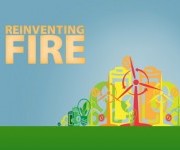Cross-posted from Climate Progress.
We almost got away with it: Before America’s comprehensive climate and energy bill turned into a devastating failure in 2010, the U.S. seemed to be on the verge of having an energy plan based on a sustainable vision for the future. But today, with “climate,” “clean energy investment,” and “green jobs” being dirty words to one major political power, we’ve moved further away from that goal than ever.
That’s why the Rocky Mountain Institute’s (RMI) recent project, “Reinventing Fire” — a peer-reviewed, commercially-viable vision for the future of energy — should help inform the future conversation around energy. In typical RMI fashion, it provides an aggressive-but-plausible scenario for economic prosperity based on clean energy and efficiency, blending together the different disciplines from the organization.
RMI’s book on Reinventing Fire will be out soon. For now, the organization reminds us where we are today and what the future could be:
- The U.S. transportation sector burns 13 million barrels of oil a day (half of it imported), at a cost of $2 billion. Personal transportation is now America’s No. 2 consumer cost after housing, totaling $740 billion in 2009 and consuming, on average, 17.6 percent of household expenditures.
- America’s 120 million buildings consume 42 percent of the nation’s energy — more than any other sector. If they were a country, they would rank third after China and the U.S. in primary energy use.
- We spend more than $400 billion a year to heat and power buildings, even more than the government spends on Medicare.
- U.S. industry employs almost 131 million people and generates more than 40 percent of U.S. GDP, but uses roughly one-fourth of the nation’s total energy per year.
- 86 percent of U.S. electricity is generated in large, centralized power plants.
What could the energy landscape of 2050 under the Reinventing Fire scenario look like?
- Efficiency efforts, plus switching from oil, coal, and one-third less natural gas to renewable energy, would save a net $5.0 trillion.
- A $2.0 trillion investment to make cars, trucks, and planes more efficient, and more effectively used, would save $5.8 trillion.
- Buildings’ energy use can be 40 to 60 percent more efficient in 2050 than today — despite 70 percent more floorspace.
- U.S. industry can produce about 84 percent more output with 9 to 13 percent less energy — without mandates or breakthroughs in innovation.
- We can capture and integrate the renewable energy needed to meet 80 percent or more of our electricity needs by 2050.
Under the plan, we could be looking at $5 trillion in net savings. If you can’t imagine that, just look at the infographic RMI put together below.

